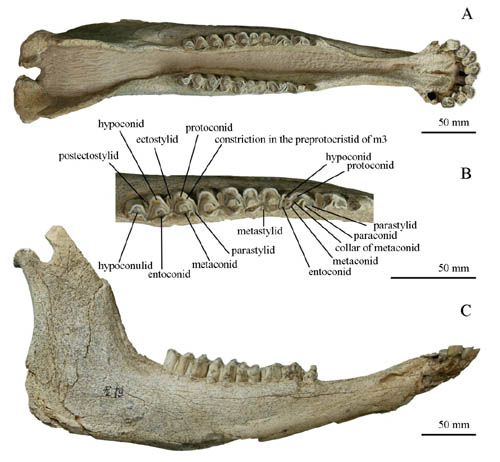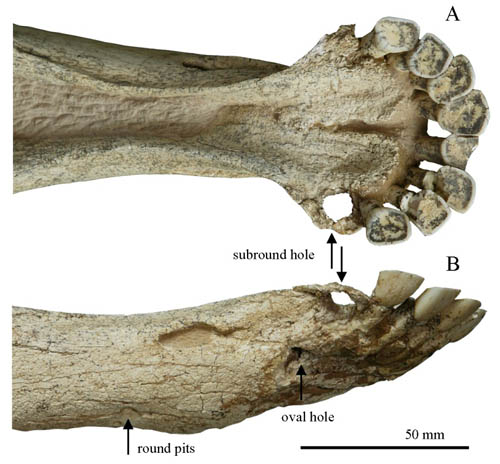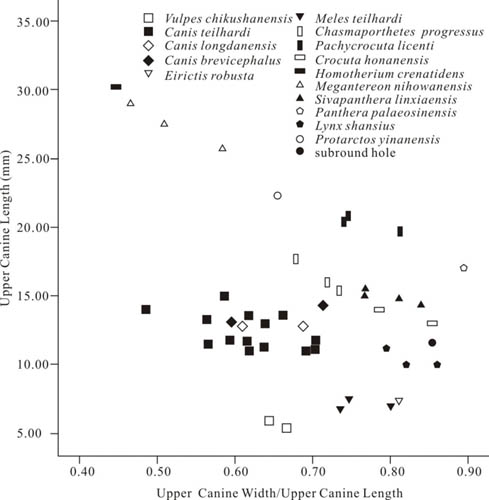A nearly complete Leptobos brevicornis mandible from the Early Pleistocene of Longdan locality in Gansu Province, northwestern China was described by LI Yikun, one of Ph.D. students from Institute of Vertebrate Paleontology and Paleoanthropology, Chinese Academy of Sciences. His paper was recently published in Issue 3, Volume 53 of Vertebrata PalAsiatica.
The new specimen supplements some characters of this bovid species. It has a long and thin mandible, and a long mandibular diastema. The premolar row is short. The mandibular body forms an obtuse angle of about 120° with the mandibular ramus, while the angle of the mandible is nearly 90°. Leptobos brevicornis may differ from Leptobos crassus in having a more developed hypoflexid in the lower fourth premolar based on the observations between the materials from Renzi Cave in Anhui Province and the revised materials from Gongwangling in Shaanxi Province.
A hole that appears to represent a wound pierces the anterior part of the mandible, located close to the right canine. The hole is subround-shaped from occlusal view. Along the labial rim of the hole, loss of bony matter and cracks on the bone slice appear to be evident. Another hole is situated posteroventrally to the subround hole, which is oval-shaped. Two additional round pits are located in the ventral border of the mandible, below the posterior margin of the mental foramen. It is barely to have opportunities to predict or study mammals’ predatory activities through fossil records, and detailed studies can only be seen in Chilotherium wimani bitten by Dinocrocuta gigantea and Iberotherim rexmanueli zbyszewskii bitten by Amphicyon giganteus. Bovids use horns as intraspecific weapons, and living bovids with horns shaped like those of Leptobos normally use them for wresting and head-on ramming in the context of fighting, obviously not the wound maker. The curvature of the interior lingual wall of the subround hole indicates that a curved object is the wound maker, and therefore the subround hole may be interpreted as the result of stabbing by the conical canine, which would imply that one carnivore was the attacker on Leptobos. There are 17 species of carnivores, however, only 11 species of herbivores, in the Early Pleistocene mammalian fauna from Longdan. Compared with the ratio of between the upper canines of known carnivores from Longdan and the subround hole, four carnivores meet the condition of the attacker, which are Lynx shansius, Panthera palaeosinensis, Sivapanthera linxiaensis and Crocuta honanensis. More detailed measurements, to measure the width of the canine when the length is nearly 11.6 mm, show that Sivapanthera and Panthera perfectly match the dimension. Lynx shansius can be excluded due to small body mass relative to that of Leptobos. The position of the wound brings to mind the predatory behavior of modern big cats. Big cats can tackle large animals by wrestling with them, seizing any chance to suffocate them with throat bites or muzzle clamps; however, dogs and hyenas prefer to attack on the abdomen or anus, to attempt to bite on the muscles of abdomen and feet. Consequently, Crocuta honanensis can be excluded from the predator. The predator is probably one individual of Sivapanthera linxiaensis or Panthera palaeosinensis. The interpretation of the wound indicates that the predatory behavior, using muzzle clamps to suffocate preys, may have already occurred in large felines during the Early Pleistocene.
This work was supported by the programs of the National Natural Science Foundation of China , the Strategic Priority Research Program of the Chinese Academy of Sciences, and the Ministry of Science and Technology of China.  Figure 1 Mandible of Leptobos brevicornis from Longdan (Image by LI Yikun)  Figure 2 Wounds in the mandible of Leptobos brevicornis (Image by LI Yikun)  Figure 3 Comparison of the width and length between upper canines of known carnivores from Longdan and subround hole (Image by LI Yikun) |


